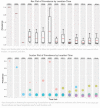DQe-v: A Database-Agnostic Framework for Exploring Variability in Electronic Health Record Data Across Time and Site Location
- PMID: 29930954
- PMCID: PMC5994933
- DOI: 10.13063/2327-9214.1277
DQe-v: A Database-Agnostic Framework for Exploring Variability in Electronic Health Record Data Across Time and Site Location
Abstract
Data variability is a commonly observed phenomenon in Electronic Health Records (EHR) data networks. A common question asked in scientific investigations of EHR data is whether the cross-site and -time variability reflects an underlying data quality error at one or more contributing sites versus actual differences driven by various idiosyncrasies in the healthcare settings. Although research analysts and data scientists have commonly used various statistical methods to detect and account for variability in analytic datasets, self service tools to facilitate exploring cross-organizational variability in EHR data warehouses are lacking and could benefit from meaningful data visualizations. DQe-v, an interactive, database-agnostic tool for visually exploring variability in EHR data provides such a solution. DQe-v is built on an open source platform, R statistical software, with annotated scripts and a readme document that makes it fully reproducible. To illustrate and describe functionality of DQe-v, we describe the DQe-v's readme document which includes a complete guide to installation, running the program, and interpretation of the outputs. We also provide annotated R scripts and an example dataset as supplemental materials. DQe-v offers a self service tool to visually explore data variability within EHR datasets irrespective of the data model. GitHub and CIELO offer hosting and distribution of the tool and can facilitate collaboration across any interested community of users as we target improving usability, efficiency, and interoperability.
Keywords: Data Quality; Data Variability; Data Warehouse; Electronic Health Records.
Figures





Similar articles
-
Moving Towards an EHR Data Quality Framework: The MIRACUM Approach.Stud Health Technol Inform. 2019 Sep 3;267:247-253. doi: 10.3233/SHTI190834. Stud Health Technol Inform. 2019. PMID: 31483279
-
A Harmonized Data Quality Assessment Terminology and Framework for the Secondary Use of Electronic Health Record Data.EGEMS (Wash DC). 2016 Sep 11;4(1):1244. doi: 10.13063/2327-9214.1244. eCollection 2016. EGEMS (Wash DC). 2016. PMID: 27713905 Free PMC article.
-
Initializing a hospital-wide data quality program. The AP-HP experience.Comput Methods Programs Biomed. 2019 Nov;181:104804. doi: 10.1016/j.cmpb.2018.10.016. Epub 2018 Nov 9. Comput Methods Programs Biomed. 2019. PMID: 30497872
-
Open source EMR software: profiling, insights and hands-on analysis.Comput Methods Programs Biomed. 2014 Nov;117(2):360-82. doi: 10.1016/j.cmpb.2014.07.002. Epub 2014 Jul 17. Comput Methods Programs Biomed. 2014. PMID: 25070757 Review.
-
Open-Source Electronic Health Record Systems for Low-Resource Settings: Systematic Review.JMIR Med Inform. 2017 Nov 13;5(4):e44. doi: 10.2196/medinform.8131. JMIR Med Inform. 2017. PMID: 29133283 Free PMC article. Review.
Cited by
-
DataGauge: A Practical Process for Systematically Designing and Implementing Quality Assessments of Repurposed Clinical Data.EGEMS (Wash DC). 2019 Jul 25;7(1):32. doi: 10.5334/egems.286. EGEMS (Wash DC). 2019. PMID: 31367649 Free PMC article.
-
Workflow Differences Affect Data Accuracy in Oncologic EHRs: A First Step Toward Detangling the Diagnosis Data Babel.JCO Clin Cancer Inform. 2020 Jun;4:529-538. doi: 10.1200/CCI.19.00114. JCO Clin Cancer Inform. 2020. PMID: 32543899 Free PMC article.
-
Developing a systematic approach to assessing data quality in secondary use of clinical data based on intended use.Learn Health Syst. 2021 May 3;6(1):e10264. doi: 10.1002/lrh2.10264. eCollection 2022 Jan. Learn Health Syst. 2021. PMID: 35036548 Free PMC article.
-
A tale of three subspecialties: Diagnosis recording patterns are internally consistent but Specialty-Dependent.JAMIA Open. 2019 Aug 5;2(3):369-377. doi: 10.1093/jamiaopen/ooz020. eCollection 2019 Oct. JAMIA Open. 2019. PMID: 31984369 Free PMC article.
-
Lost in Translation: Diagnosis Records Show More Inaccuracies After Biopsy in Oncology Care EHRs.AMIA Jt Summits Transl Sci Proc. 2019 May 6;2019:325-334. eCollection 2019. AMIA Jt Summits Transl Sci Proc. 2019. PMID: 31258985 Free PMC article.
References
-
- Institute of Medicine. Capturing Social and Behavioral Domains and Measures in Electronic Health Records: Phase 2. Washington (DC): The National Academies Press; 2014. - PubMed
-
- Hsiao C-J, Hing E, Socey TC, Cai B. Electronic health record systems and intent to apply for meaningful use incentives among office-based physician practices: United States, 20012011. NCHS Data Brief. 2011:1–8. http://www.ncbi.nlm.nih.gov6/pubmed/22617322. - PubMed
Grants and funding
LinkOut - more resources
Full Text Sources
Other Literature Sources
